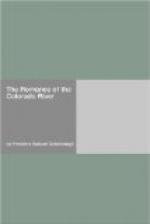All the tribes of this region, being familiar with the Californian coast, described it in a way that caused Onate to believe that the gulf was the South Sea, extending indefinitely beyond the mouth of the Colorado northwards, and thus the persistent error that Lower California was an island received further confirmation. Without going across to the sea beyond the mountains, which would have dispelled the error, Onate returned to the Rio Grande by the outward route, suffering so greatly for food that the party were forced to eat some of their horses, a source of relief often resorted to in future days in this arid country. A few years after Onate’s expedition Zalvidar (1618), with Padre Jiminez and forty-seven soldiers, went out to Moki, and from there fifteen leagues to the Rio de Buena Esperanza, but they evidently encountered Marble Canyon, and soon returned.
Another name closely linked with the early history of the Colorado is that of Padre Eusibio Francisco Kino,* an Austrian by birth and a member of the Jesuit order. This indefatigable enthusiast travelled back and forth, time and again, over the whole of northern Sonora and the southern half of Arizona, then comprised in Pimeria Alta, the upper land of the Pimas, and Papagueria, the land of the Papagos. His base of operations was a mission he established in Sonora; the mission of Dolores, founded in 1687. For some thirty years Kino laboured in this field with tireless energy, flinching before no danger or difficulty. He was the first white man to see the extraordinary ruin called Casa Grande, near the present town of Florence, and on the occasion of his first visit he took advantage of the structure to say mass within




